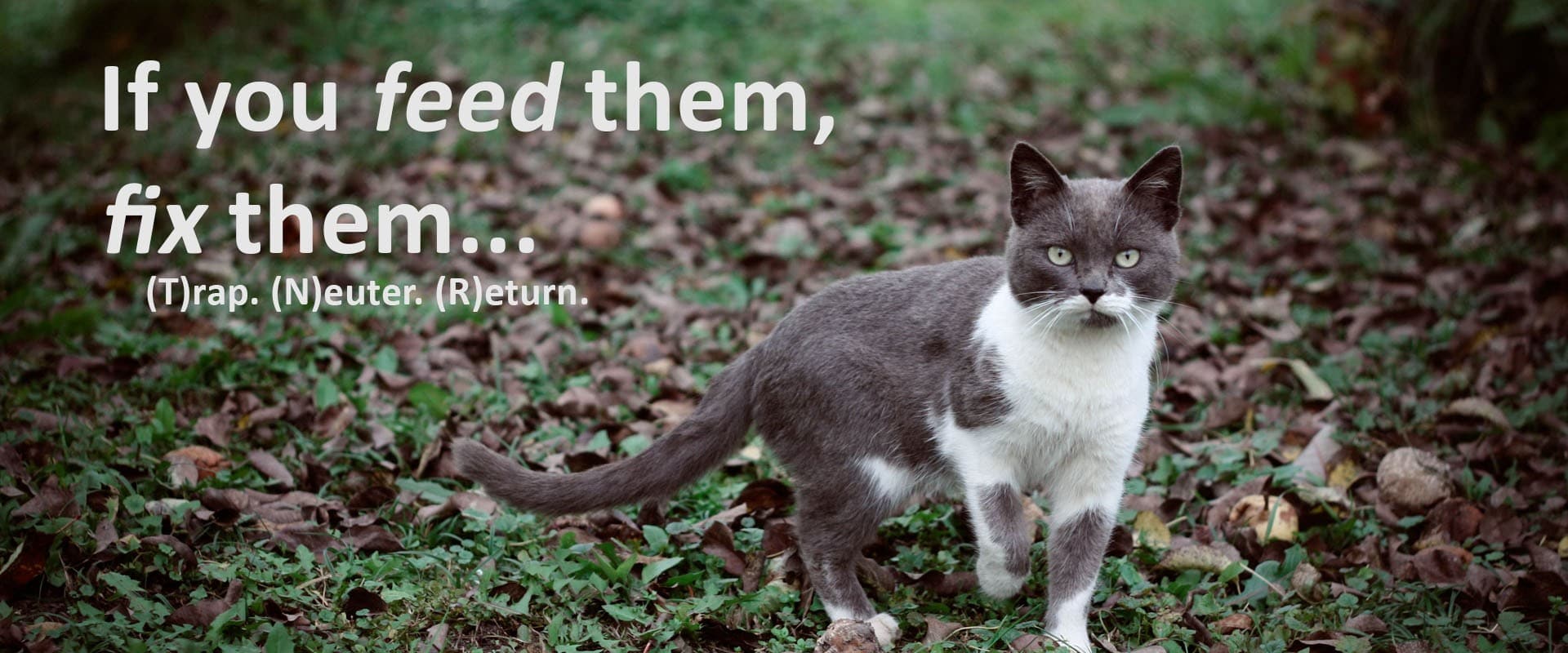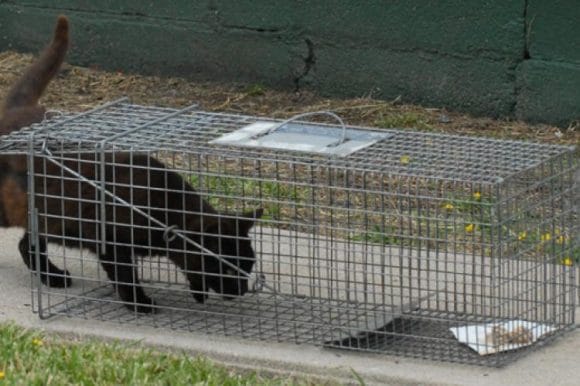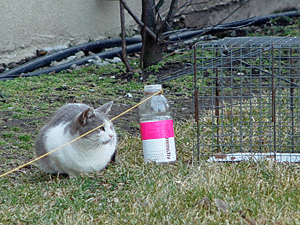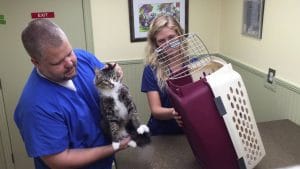Trap Neuter Return Instructions and Tips to Succeed!

The hardest part about TNR (Trap Neuter Release)- is finding that ONE motivated individual who is willing to make a huge difference. Setting traps and taking cats to and from the veterinary clinic to be fixed, is more work than simply tossing out food for them to eat. If you are waiting for someone to help you-many times you’ll come up empty handed and your problem will only get worse, but don’t worry- Furry Nation Salvation is here to help you along in this process! It is much easier than you think. We can even help with transport on certain days. We also have metal traps we can loan out.
Look below to find out some tips and tricks to help YOU succeed.
If you’re located within Volusia County click here for informationon how to registered your cat colony to get no cost spay and neuter & vaccinations. If you live outside of Volusia County or want a list of low cost / no cost spay and neuter locations, click here.
MAKE AN APPOINTMENT FIRST BEFORE TRAPPING.
Have a plan before attempting to trap a cat. An appointment should be set. Never set a trap on a weekend or near a holiday as there are no vets available during these times.
WHERE TO PLACE THE TRAP?
Place the traps at the location where you are feeding the cats.
WHAT FOOD TO USE TO TRAP?
It is best to use a smelly food. Try wet cat food, tuna, or maceral as bait. You may also find that using their typical food works best.
BEST WAYS TO CATCH A CAT IN A TRAP
(also consider watching YouTube videos)
Option A: Setting the trap as normal
Set the trap(s) near the cat’s normal feeding area. Check on the trap often to see if you caught him. Be careful not to set the trap directly in the sun or on an ant hill.

Option B: Using a trap for daily feeding (for those trap savvy felines)
Use your trap to feed the cat in! That means you are only allowed to put food INSIDE THE TRAP, which will get the cat going in and out of it on a regular basis. Use a zip tie or twist tie to keep the trap door OPEN so the cat can go in and out for their food daily. You can start by putting the food in front of the open door – move it further into the trap each day until the cat is going into the trap. This may take a few days. Once you have an appointment set, remove the zip tie, place the food to the VERY back of the cage (away from the tripping mechanism) and set the trap as normal. Catching a cat with this method is very easy.
Option C: Water bottle method
Sometimes catching the RIGHT cat can be tricky. Especially with fixing the last few cats in a huge colony. Grab a plastic water or Gatorade bottle. Fill it half way with water. Using a string, tie it around the neck part of the bottle and place the water bottle under the door of the trap. Place food to the very back of the cage. Once the right cat walks in for the food, you pull the string attached to the water bottle to close the door! Practice a few times to make sure the string will pull the water bottle well.
Note: Please make sure that the door at the rear of the trap is secure so once the cat is in the trap it cannot escape.

Option D: Using a cat’s babies as lure

Placing tiny kittens into the back of the trap is a great way to catch a mother who is desperate to help her own babies. You can use a smaller trap to place inside a regular Havahart trap (so the babies don’t escape). Using the water bottle method works well here. If the kittens are small enough and won’t trip the mechanism, setting the trap up like normal could also work.
USING A CAT CARRIER FOR TRAPPING
(if allowed)
Option A: Vertical carrier/Scruff neck method
If you can handle the cat you might be able to put him into a carrier (As long as the facility you will be taking him to allows a carrier). Stand the carrier on end (vertical) with the open door facing upward. Put the carrier close to the location where you are feeding/touching the cat. Pick up the cat by the scruff of the neck (like a mother cat carries a kitten) and hold it out at arm’s length with the feet dangling keeping a tight grip on the loose skin at the back of the neck. DO NOT TRY TO CRADLE THE CAT AGAINST YOUR BODY OR TOUCH THE REAR FEET.Drop the cat – rear legs first into the carrier and quickly close the door.
*UNDER NO CIRCUMSTANCES SHOULD YOU TRY TO PUT THE CAT INTO THE CARRIER HEAD FIRST AS YOU COULD BE BITTEN OR SCRATCHED.

Option B: String & Bait method
You can also trap the cat in a hard plastic carrier (if the spay/neuter facility allows carriers) by tying a long string/cord onto the door of the carrier near the locking mechanism and pulling the cord back through one of the holes along the sides or back of the cat carrier. Bait the carrier with a very small amount of smelly food and when the cat goes into it, pull on the string to close the door. Keep tension on the string until you can secure the lock.
BEST TIME TO TRAP A CAT
The best time to try to capture cats is early in the morning so you can take them directly to the spay/neuter clinic. Note: When trapping in the morning use a small amount of tuna juice to lure the cat into the trap as they will be going under anesthesia and should not have undigested food in their stomachs. Please tell the vet at approximately what time in the morning the cat ate.
If you have a harder to trap cat, try the evening or day before! Remember, if you catch the cat early you can still place wet food and water inside the metal trap by opening the door very slightly. Also make sure to place the trapped cat in a shady area (not near any ant hills) or on a porch. Cover with a sheet or towel-making sure cat has normal ventilation ad won’t get too hot in the summer or to cold in the winter.
RACCOONS AND POSSUMS
It is very probable that you will get a wild animal. Always use gloves and be very cautious when releasing. Try to use traps that have a second door (release door) at the rear of the trap. You can use this door for easy release or for feeding during rehab.
CAT IS TRAPPED! NOW WHAT?
When the cat is trapped put a sheet or large towel over the trap to calm the cat. Make sure that the cat has sufficient air. Pick up the trap by the handles. Do not put your fingers in the trap and do not try to pet the cat. Note: Cats will try to escape from the trap and it is normal for them to bloody their noses or paws on the wire cage – DO NOT RELEASE THE CAT UNDER ANY CIRCUMSTANCES AS IT WILL BE DIFFICULT IF NOT IMPOSSIBLE TO CAPTURE THE CAT AGAIN.
THINGS TO CONSIDER WHEN PUTTING A TRAPPED CAT INTO YOUR VEHICLE
Before putting the cat/trap into your vehicle make sure that you put plastic over the carpet and/or seats (cover the backs of seats too) as the cat might urinate, spray or throw up as it is frightened and agitated because it is in a trap. On top of the plastic put down an old towel or blanket (to help absorb any liquids). Note: Plastic tablecloths, shower curtains, tarps or drop cloths work very well to protect the car.
TAKE THE CAT TO THE VET (don’t be late)
Take the cat to the designated veterinary clinic where the pre-arranged appointment has been setup. Please make sure you have asked about drop off and pickup times when making the appointment. Note: Drop off time at the Redinger Clinic in Daytona for Friday appointments is between 8:00 – 8:55 a.m.
WHAT WILL GET DONE FOR THE CAT AT THE CLINIC?
Vet Clinic will spay/neuter the cat, vaccinate for rabies and distemper, tip its ear and administer a pain shot. They will place the cat back in the trap or carrier after surgery. NOTE: If you are taking the cats to the veterinarian in a carrier (if allowed) instead of a trap please make sure that the carrier is clean as the cat will be put back into the carrier after surgery.
VERY IMPORTANT: ONLY ONE CAT PER CARRIER – NO EXCEPTIONS!
TIME FOR PICK-UP FOR CAT
Please ask about the pickup time and be on time for both drop off and pickup.
WHERE TO PLACE CAT/TRAP AFTER FIXING
When you bring the cat home, place the cat trap on a surface that can be cleaned in case the cat defecates or urinates (garage, screened porch, etc). If inside your garage or porch place an absorbant material (old towel or blanket) so urine can be soaked up. Make sure that the recovery location is not too hot in summer or too cold in winter and make sure that it is dry and out of the weather. Remember DO NOT try to pet the cat or to remove it from the trap when you bring it home as you could be bitten or scratched as the cat will be stressed and unpredictable. DO NOT let children or other pets touch the cat or try to play with it after surgery.
MALE CAT RELEASE AFTER FIXING
Male cats recover very quickly and can be ready for release the evening you bring them home or the next morning (we recommend daylight release). If you keep them overnight make sure that they are in a sheltered area that is dry with a comfortable temperature you can feed him and give him water by pushing it under the rear door of the trap – remember to secure the door after opening it.
Note: Make sure that before you release the cat that you assess his condition to make sure that he has recovered from the surgery without issue and is capable of being on his own.
FEMALE CAT RELEASE AFTER FIXING
Female cats need to be kept in a sheltered area that is dry with a comfortable temperature until her incision has time to heal; the female cat can be ready for release as soon as 24 hours after surgery (keep her in the trap overnight) as recovery can take several days depending on the situation. You can feed her and give her water by pushing it under the rear door of the trap – remember to secure the door after opening it.
Note: Make sure that before you release the cat that you assess her condition to make sure that she has recovered from the surgery without issue and is capable of being on her own.
Note: Cats cannot regulate their body temperature after anesthesia, so please monitor them to make sure that they are not in distress or bleeding from their Incisions or any other condition that is unusual during recovery after surgery.
RELEASE CAT BACK TO SAME AREA
This is very important, make sure that you release the cats back into the colony or the area where they were trapped at. If not, cats will try go back to where they came from and many times get killed in the process (prey-no food/water source).
RELOCATION DOES NOT WORK WITH FREE ROAMING OR FERAL CATS.
QUESTIONS OR CONCERNS
Please contact your municipality’s TNR contact person with questions about the program; appointments for surgery; or for any issues with the cat before or after surgery. Do not contact the spay/neuter clinic directly for appointments or program questions.
HAVE A FRIENDLY CAT YOU WOULD LIKE TO REHOME?
Contact Furry Nation Salvation to start their Rehoming Assistance Program. Click here to learn more.
